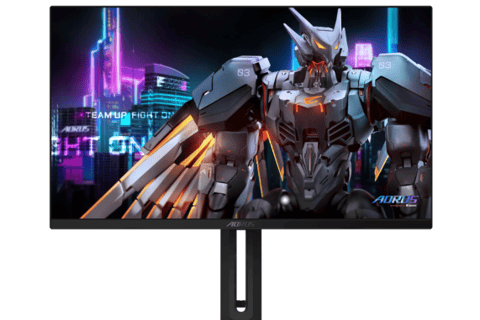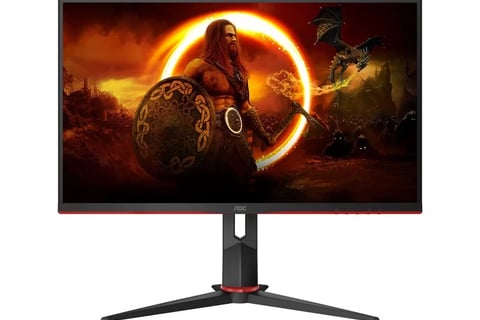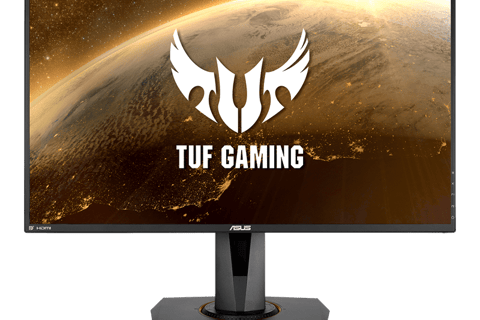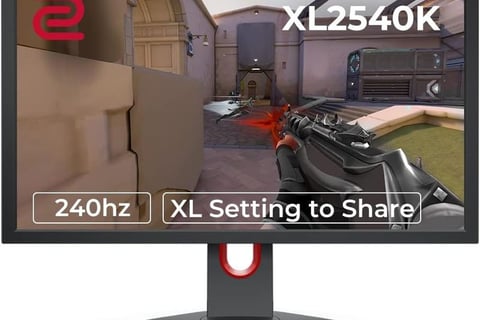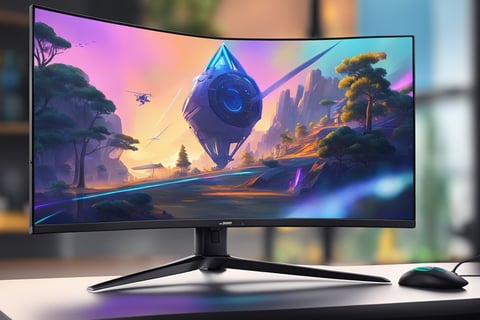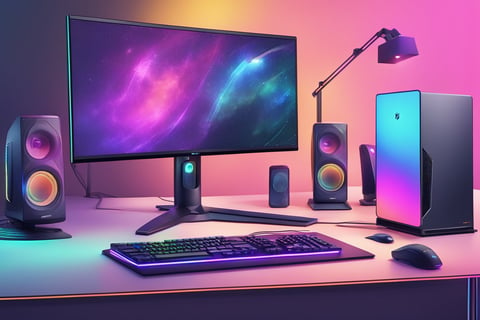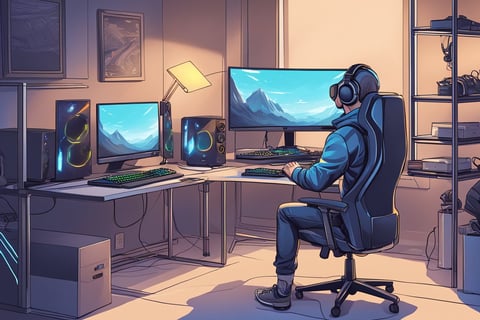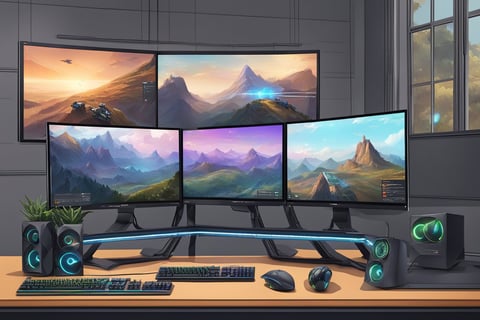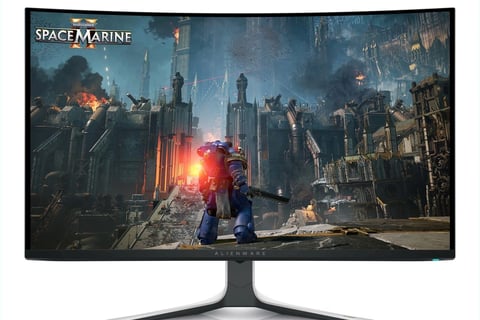Best 240hz Monitors for Competitive Gaming
3/13/2025
When buying a 240 Hz monitor for competitive FPS gaming, gamers must consider several key factors that can impact performance. The refresh rate allows for smoother gameplay and quicker responses, but is equally important to ensure that the monitor supports low input lag and has a fast response time. These features combine to provide a more immersive experience, crucial for competitive play
Additionally, resolution and panel type play significant roles in image quality and performance. Players should look for a monitor that balances these aspects, ensuring that they can maintain high frame rates while enjoying crisp visuals. It's also essential to consider adaptive sync technologies, like G-Sync or FreeSync, as they help eliminate screen tearing and stuttering during intense gameplay.
Lastly, connectivity options and build quality are important considerations. A monitor with multiple input ports allows for future upgrades, while a sturdy design can withstand the rigors of competitive gaming. By taking these elements into account, gamers can make an informed choice that enhances their gaming experience.
Top 5 Best 240 Hz Monitors
Selecting the right monitor can enhance the competitive gaming experience significantly. Here are five of the top choices for 240Hz monitors that excel in fast-paced FPS gaming.
Screen Size: 27 inches
Resolution: 2560 x 1440
HDR Compatibility: HDR10
Refresh Rate: 240Hz
Inputs:
2 x HDMI 2.1
1 x DisplayPort 1.4
1 x USB Type-C (DisplayPort Alt Mode)
2 x USB-A 3.2 Gen 1
Aspect Ratio: 16:9
Panel Type: QD-OLED
Response Time: 0.03ms
The Gigabyte AORUS FO27Q2 is engineered for competitive gamers who demand top-tier performance and cutting-edge display technology. Featuring a QD-OLED panel, this monitor delivers exceptional color accuracy, deep blacks, and ultra-fast response times, ensuring a seamless and immersive gaming experience. With a 240Hz refresh rate and 0.03ms response time, players can expect fluid motion with virtually no ghosting, providing a crucial edge in fast-paced gameplay.
Designed with next-generation connectivity options, including HDMI 2.1 and DisplayPort 1.4, the FO27Q2 is fully optimized for both high-performance PC gaming and the latest gaming consoles. Additionally, its AI-driven OLED care technology ensures a longer panel lifespan by mitigating burn-in risks, making it a reliable choice for serious gamers.
The Gigabyte AORUS FO27Q2 sets itself apart with superior panel technology, industry-leading response times, and advanced gaming features, making it a standout choice for competitive esports players and high-performance gaming enthusiasts.
Screen Size: 27 inches
Resolution: 1920 x 1080 (Full HD)
HDR Compatibility: Not specified
Refresh Rate: 240Hz
Inputs:
2 x HDMI 2.0
1 x DisplayPort 1.2
1 x 3.5mm Audio Out
Aspect Ratio: 16:9
Panel Type: VA
Response Time: 1ms MPRT
The AOC Gaming 27G2ZNE is a budget-friendly option for gamers looking for high-refresh-rate performance without breaking the bank. This 27-inch Full HD monitor is designed for smooth and responsive gameplay, making it a great choice for both competitive and casual players.
With a 240Hz refresh rate and 1ms MPRT response time, it ensures ultra-fluid motion and minimal blur, giving players a clear advantage in fast-paced games. Additionally, Adaptive Sync technology helps eliminate screen tearing and stuttering, delivering a seamless and immersive gaming experience. Equipped with HDMI 2.0 and DisplayPort 1.2 connectivity, the 27G2ZNE is compatible with a wide range of gaming setups.
Positioned as a cost-effective alternative to premium gaming monitors, the AOC 27G2ZNE offers the essential features needed for a competitive gaming experience. Its combination of high-speed performance, adaptive technology, and affordability makes it an excellent choice for gamers looking for smooth, tear-free visuals at a great price.
3. Alienware AW3225QF (Curved)
Screen Size: 31.6 inches
Resolution: 3840 x 2160 (4K UHD)
HDR Compatibility: Yes, supports HDR10 and Dolby Vision
Refresh Rate: 240Hz
Inputs:
2 x HDMI 2.1
1 x DisplayPort 1.4
1 x USB 3.2 Gen 1 Type-B
3 x USB 3.2 Gen 1 Type-A
1 x USB 3.2 Gen 1 Type-C
Aspect Ratio: 16:9
Panel Type: QD-OLED
Response Time: 0.03ms
The Alienware AW3225QF stands as a testament to high-end gaming display technology, offering a suite of features tailored for an unparalleled gaming experience. Its 32-inch QD-OLED panel delivers stunning 4K resolution (3840 x 2160), ensuring crystal-clear visuals with vibrant colors and deep blacks. The monitor's 240Hz refresh rate and 0.03ms (gray-to-gray) response time provide exceptionally smooth and responsive gameplay, crucial for competitive gaming scenarios.
Compatibility with NVIDIA G-SYNC and VESA AdaptiveSync ensures tear-free and stutter-free visuals, enhancing overall immersion. Connectivity options are robust, including two HDMI 2.1 ports, one DisplayPort 1.4, and multiple USB ports, accommodating a wide range of gaming setups.
While the AW3225QF commands a higher price point, its advanced features and superior performance justify the investment for gamers seeking top-tier display quality
4. ASUS TUF Gaming VG279QM
Screen Size: 27 inches
Resolution: 1920 x 1080 (Full HD)
HDR Compatibility: HDR10, DisplayHDR 400 certified
Refresh Rate: 240Hz
Inputs:
1 x DisplayPort 1.2
2 x HDMI 2.0
1 x 3.5mm Earphone Jack
Aspect Ratio: 16:9
Panel Type: Fast IPS
Response Time: 1ms (GTG)
The ASUS TUF Gaming VG279QM is built for serious gamers who demand speed, responsiveness, and smooth visuals. This 27-inch Full HD (1920 x 1080) monitor features a Fast IPS panel with a 240Hz refresh rate and 1ms (GTG) response time, delivering ultra-fluid motion and crisp clarity for fast-paced gameplay.
With HDR10 support and DisplayHDR 400 certification, the monitor enhances contrast and color accuracy for a more immersive experience. Additionally, it is G-SYNC Compatible, reducing screen tearing and stuttering by enabling variable refresh rate (VRR) for seamless gameplay.
ASUS TUF Gaming VG27AQ – This model offers a higher 2560 x 1440 (QHD) resolution but only a 165Hz refresh rate. The VG279QM at 240Hz is better suited for gamers prioritizing speed, while the VG27AQ caters to those who prefer higher resolution over refresh rate.
Acer Nitro XV273 Xbmiiprzx – Both monitors have 240Hz refresh rates and IPS panels, but the VG279QM offers better ergonomics and slightly faster response times, reducing motion blur for smoother visuals.
BenQ Zowie XL2746S – Designed for competitive FPS gamers, this monitor has a 240Hz refresh rate but uses a TN panel, which provides slightly faster response times but at the cost of color accuracy and viewing angles compared to the VG279QM’s Fast IPS panel.
The ASUS TUF Gaming VG279QM strikes a perfect balance between high refresh rates, fast response times, and IPS-level color accuracy, making it an ideal choice for competitive gamers looking for a 240Hz monitor without sacrificing display quality.
While some alternatives may offer higher resolutions or different panel technologies, the VG279QM’s combination of speed, smooth visuals, and gaming-focused features makes it a top-tier choice in the high-refresh-rate monitor category.
5. BenQ ZOWIE XL2540K
Screen Size: 24.5 inches
Resolution: 1920 x 1080 (Full HD)
HDR Compatibility: Not specified
Refresh Rate: 240Hz
Inputs:
3 x HDMI 2.0
1 x DisplayPort 1.2
1 x 3.5mm Headphone Jack
Aspect Ratio: 16:9
Panel Type: TN
Response Time: 1ms
The BenQ ZOWIE XL2540K is engineered for esports enthusiasts and competitive gamers seeking exceptional speed and responsiveness. This 24.5-inch Full HD (1920 x 1080) monitor features a TN panel with a 240Hz refresh rate and a 1ms (GtG) response time, ensuring fluid and precise visuals during high-paced gaming sessions.
In summary, the BenQ ZOWIE XL2540K is tailored for gamers who prioritize speed and responsiveness, offering a 240Hz refresh rate and rapid 1ms response time. While its TN panel may not provide the same color richness and viewing angles as IPS counterparts, its features like Black eQualizer and Color Vibrance cater specifically to competitive gaming needs. Gamers seeking enhanced color accuracy and wider viewing angles might consider IPS alternatives, but for those focused on performance, the XL2540K remains a compelling choice
Key Features to Look for in a 240 Hz Monitor
When choosing a 240 Hz monitor for competitive FPS gaming, several critical features play a significant role in enhancing performance. Refresh rate, resolution, response time, and panel type all directly impact the gaming experience. Understanding these aspects helps in making an informed decision.
Refresh Rate Importance for FPS Games
A refresh rate of 240 Hz offers smoother gameplay and better responsiveness, crucial for competitive FPS games. This high refresh rate reduces motion blur, providing clearer images during fast movements. Players can track opponents more effectively, leading to a competitive edge.
Many monitors also support adaptive sync technologies like G-Sync or FreeSync. These features reduce screen tearing, creating a fluid experience during intense gaming sessions. A monitor with a stable 240 Hz refresh rate ensures a responsive feel, allowing for quick reactions and improved accuracy.
Resolution and Panel Size
Resolution impacts image clarity and detail. Common resolutions for 240 Hz monitors include Full HD (1920x1080) and Quad HD (2560x1440). While 1080p is more common in competitive settings due to higher frame rates, 1440p offers a balance between detail and performance.
Panel size is also important. Monitors generally range from 24 to 27 inches for competitive gaming. A larger screen can enhance immersion, but it can also lead to increased pixel density concerns. Choosing a suitable size depends on personal preference and gaming setup.
Response Time and Input Lag
Response time measures how quickly a pixel can change colors. A monitor with a low response time (1 ms or lower) minimizes ghosting effects, vital for fast-paced gaming. Input lag, the delay between an input and the on-screen response, should also be minimal (ideally below 10 ms).
Reduced input lag ensures that commands translate quickly into action on-screen. A responsive monitor allows players to react swiftly, which is essential in competitive environments. It is important to look for monitors with both low response times and minimal input lag for optimal performance.
Panel Type Pros and Cons
Panel type significantly influences color accuracy, viewing angles, and response times. The three primary types are TN, IPS, and VA panels.
TN (Twisted Nematic): Known for fast response times and low input lag, TN panels are popular among competitive gamers. They usually have poorer color reproduction and viewing angles.
IPS (In-Plane Switching): IPS panels offer superior color accuracy and wider viewing angles. However, they often have slightly higher response times than TN panels, which can affect performance.
VA (Vertical Alignment): VA panels provide good color reproduction and great contrast ratios but typically have slower response times. This makes them less ideal for competitive gaming.
Choosing the right panel type depends on personal preferences regarding performance and visual quality.
Compatibility and Connectivity
When purchasing a 240 Hz monitor for competitive FPS gaming, it is crucial to consider compatibility with existing hardware and the connectivity options available. Proper graphics card support and the correct types of cables can significantly affect performance.
Graphics Card Requirements
A suitable graphics card is essential to maximize the benefits of a 240 Hz monitor. Most modern GPUs can support high refresh rates, but specific models offer better performance.
NVIDIA: GTX 16-series, RTX 20-series, and RTX 30-series are ideal.
AMD: Radeon RX 5000 and RX 6000 series provide solid performance.
System specifications should support high frame rates. CPUs and RAM must complement the GPU for optimal results. Check games to ensure the GPU can consistently provide 240 FPS for a smooth experience.
Available Ports and Cables
Connectivity options on a monitor are critical for performance and compatibility. Common ports include HDMI and DisplayPort.
DisplayPort 1.4: Offers support for 240 Hz at higher resolutions.
HDMI 2.1: Supports 240 Hz at 4K but is less common in older models.
Ensure the selected monitor and graphics card have matching ports. Using the correct cable is vital; for instance, DisplayPort cables provide higher bandwidth than HDMI cables. Always confirm the specifications of both the monitor and cables to avoid compatibility issues.
Adaptive Sync Technology Compatibility
Adaptive Sync technology can further enhance gaming performance by reducing screen tearing and stuttering. Key technologies include:
NVIDIA G-Sync: Optimizes performance for NVIDIA GPUs.
AMD FreeSync: Works with compatible AMD GPUs.
It is crucial to confirm the monitor's support for these technologies. Some monitors support both, while others may only work with one. This compatibility can directly affect the gaming experience, making it an important consideration for competitive play.
